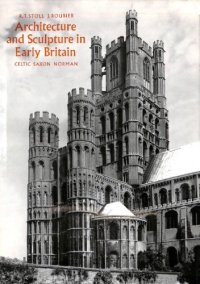
Ebook: Architecture and Sculpture in Early Britain: Celtic, Saxon, Norman
Author: Robert Stoll
- Genre: Art
- Year: 1967
- Publisher: The Viking Press
- City: New York
- Language: English
- pdf
With photographs by Jean Roubier.
"Britannia Romanica". Translated from the German by J. Maxwell Browjohn.
The achievements of the Romanesque style — often referred to in Britain as Saxon and Norman — can in many ways be more fully appreciated in Britain than anywhere else in Europe. No other country can boast such a magnificent series of cathedrals built between the late 11th century and 1300: Durham, Winchester, Ely, Peterborough, Norwich, Chichester, Rochester, to name some of the finest. Hardly less imposing are the abbeys and priories now used as parish churches: Southwell, Christchurch, Worksop, Blyth, Romsey and many more. And hundreds of smaller churches survive all over the country, from Kilpeck in Herefordshire to Barfreston in Kent. Now nearly nine hundred years old, they have grown into the English countryside and have become an integral part of British culture and history. To them must be added what remains of pre-Conquest architecture (small in scale but often exquisite in quality) and the contribution of Ireland, with its superb series of Celtic crosses. From these buildings a wealth of sculpture survives, much of it still "in situ" — tympana, capitals, fonts, decorative motifs on façades and arches — leading us abruptly into the teeming world of the Romanesque imagination: the passion of Christ and His saints inextricably blended with the monsters of a more remote mythology. Many of these works, such as the reliefs of the Harrowing of Hell and the Raising of Lazarus at Chichester, are masterpieces comparable with any of later times; and surviving wall-paintings, though few and mutilated, have the same sombre power.
These marvels of medieval art are fully represented in this book in a sequence of over 250 new photographs, which capture both the total impression given by a Romanesque building and the strange fascination of its details. Each plate is accompanied by an authoritative commentary which conveys the essential historical and architectural information. Here is the essence of a style and of an age — an age in which grandeur was combined with delicacy and strength with beauty; and in which the faith that was moulding medieval Christianity found its first and most commanding expression.
"Britannia Romanica". Translated from the German by J. Maxwell Browjohn.
The achievements of the Romanesque style — often referred to in Britain as Saxon and Norman — can in many ways be more fully appreciated in Britain than anywhere else in Europe. No other country can boast such a magnificent series of cathedrals built between the late 11th century and 1300: Durham, Winchester, Ely, Peterborough, Norwich, Chichester, Rochester, to name some of the finest. Hardly less imposing are the abbeys and priories now used as parish churches: Southwell, Christchurch, Worksop, Blyth, Romsey and many more. And hundreds of smaller churches survive all over the country, from Kilpeck in Herefordshire to Barfreston in Kent. Now nearly nine hundred years old, they have grown into the English countryside and have become an integral part of British culture and history. To them must be added what remains of pre-Conquest architecture (small in scale but often exquisite in quality) and the contribution of Ireland, with its superb series of Celtic crosses. From these buildings a wealth of sculpture survives, much of it still "in situ" — tympana, capitals, fonts, decorative motifs on façades and arches — leading us abruptly into the teeming world of the Romanesque imagination: the passion of Christ and His saints inextricably blended with the monsters of a more remote mythology. Many of these works, such as the reliefs of the Harrowing of Hell and the Raising of Lazarus at Chichester, are masterpieces comparable with any of later times; and surviving wall-paintings, though few and mutilated, have the same sombre power.
These marvels of medieval art are fully represented in this book in a sequence of over 250 new photographs, which capture both the total impression given by a Romanesque building and the strange fascination of its details. Each plate is accompanied by an authoritative commentary which conveys the essential historical and architectural information. Here is the essence of a style and of an age — an age in which grandeur was combined with delicacy and strength with beauty; and in which the faith that was moulding medieval Christianity found its first and most commanding expression.
Download the book Architecture and Sculpture in Early Britain: Celtic, Saxon, Norman for free or read online
Continue reading on any device:

Last viewed books
Related books
{related-news}
Comments (0)